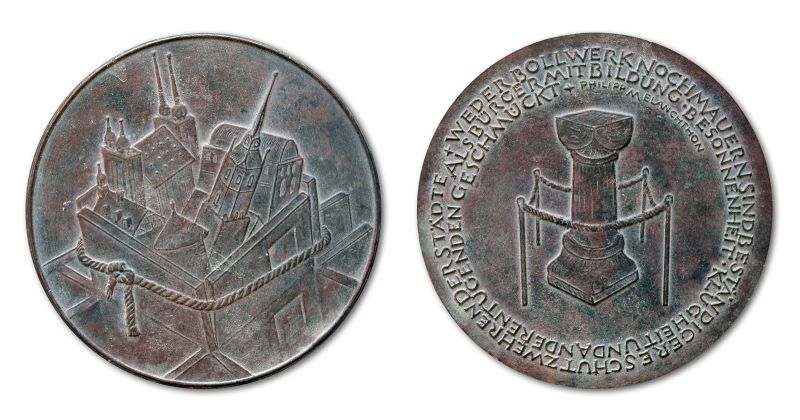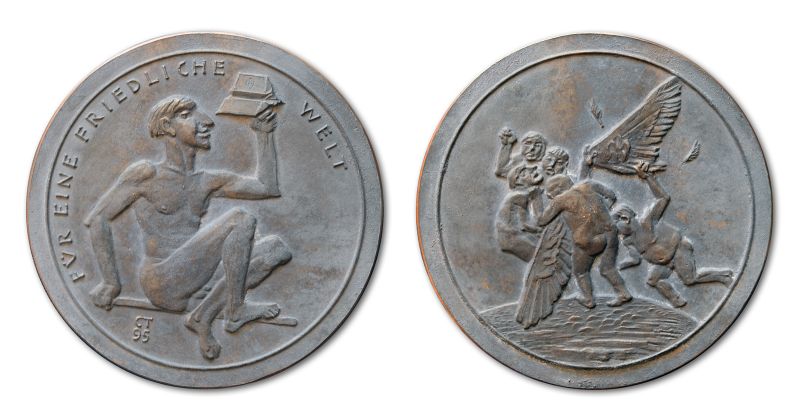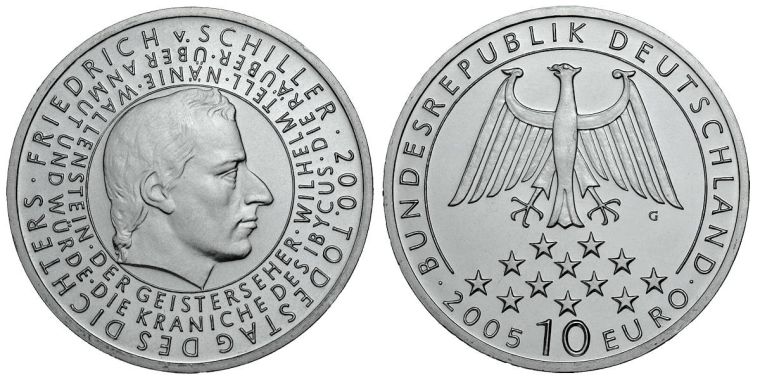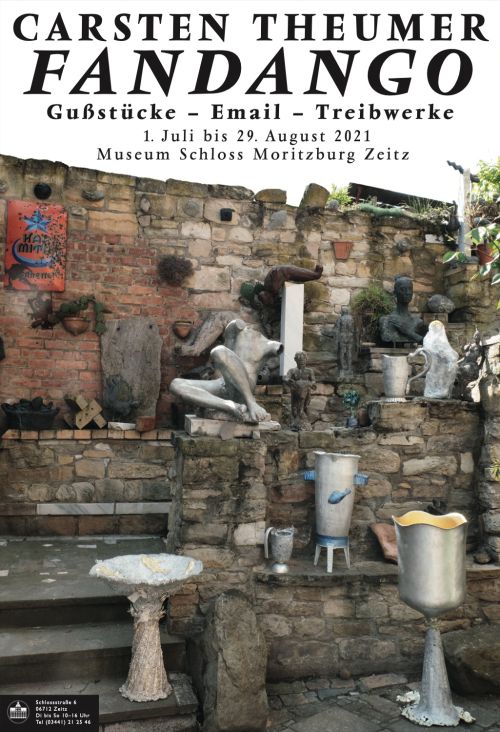text: Dr. Wolfgang Steguweit
Eulogy in honour of Carsten Theumer, winner of the German Medalist Award 2023
Exactly 50 years ago, an expert from the museum in Gotha travelled to Halle to discuss the first retrospective on the art of medal making in the German Democratic Republic (1974) – planned to be held at the Friedenstein Palace museum in Gotha – with the head of the sculpting class at Burg Giebichenstein University for Industrial Design, Gerhard Lichtenfeld (1921-1978), and his assistant and lecturer Bernd Göbel. At the time, the star of the medal world who would later sign his works “CT”, or just “T”, had not yet risen. Three years later, at the age of 21, Carsten Theumer began studying sculpture under Bernd Göbel at the “BURG”. After completing his post-graduate studies, and an intermezzo as a freelancer in 1990, he became Göbel’s assistant and artistic associate at the faculty of sculpture at what had now been named the University of Art and Design.
In 1989/90, the Coin Collection of the Staatliche Museen zu Berlin cooperated with the Bavarian State Coin Collection in Munich to develop the highly acclaimed exhibition on the “Wende”, or turn-around, in the GDR and the beginning reunification process. The exhibition was shown in Munich, Berlin, Bonn, Nuremberg and Gotha; the Halle medal created by Carsten Theumer in 1988 garnered especial attention. (Fig. 1)

Fig. 1, bronze cast, 103 mm
The exhibition catalogue describes the medal as follows:
“The historic city centre with its market church of St. Mary’s and the Red Tower has been surrounded (“protected”) by a fictional wall and additionally secured by ropes. But even these precautions cannot stop the city’s interior deterioration, ‘as neither bulwarks nor walls provide a city with a more dependable and persistent defence than citizens that have been gifted with education, common sense, wisdom and other virtues.’” (Author’s translation. Source text: “denn weder Bollwerk noch Mauern sind beständigere Schutzwehren der Städte als Bürger mit Bildung, Besonnenheit, Klugheit und anderen Tugenden geschmückt”.)
Theumer took this quote by Philipp Melanchthon, who had dedicated these words to the foundation of St. Egidien Latin School in Nuremberg (today the Melanchthon-Gymnasium) in 1526, and skilfully applied it to his native hometown of Halle. On the medal, the market church of Our Lady appears as a solid castle; the Red Tower, on the other hand, seems just about to fall. However, the tower remained largely upright when the doctoral candidate from Gotha came to Halle for his seminars, walking through the city centre to the Art History Institute at Martin Luther University Halle-Wittenberg, situated on the Kaulenberg. But one could already see the creeping architectural decay wherever one looked, including throughout the historic city centre of Halle. The falling tower on the medal may therefore be both a metaphor for the imminent decline of the GDR and a warning signal for politics and the media. Unlike the one-dimensional reflections in the “leading media” – then and now – the medal as “art for the hand” is able to critically exaggerate reality, to reflect it in images that stay with us, and thus encourage us to think and differentiate by way of our aesthetic-sensual perception.
This medal was the first to show Theumer’s rising star. From that moment on, “medal astronomers” – aficionados and lovers alike – followed Carsten Theumer on his artistic ‘orbit’.
In the following, some of the unique relief language he uses in the images on his medals have been decoded pars pro toto. The author selected the majority of them from his own, small collection.
1991: Ex occidente felicitas (Blessed with Bananas, “Bananensegen”)

Fig. 2, bronze cast, 100 mm
A man crouches on an uncomfortable, hilly island, bananas sprouting from his ears and wide open mouth, their peels covering his head. The translated circumscription “happiness (comes) from the West” lacks a question mark. And yet we can place the man, as he waves a small flag, out of which the state crest has been cut, in the right hand of his crossed arms. (Fig. 2)
On the back, a hand reaches longingly towards the clouds, from which the saviour hands down a banana. “Deceived with grateful thanks to yonder slumbering one?” Goethe’s Prometheus asked in 1774. While bananas were once highly sought after, as they were difficult to come by outside of Berlin, the capital of the GDR, this one does not seem of much use when it comes to salvation. Or would that be pointing a finger?
1995:
50 years after the end of World War II, the German Society for Medallic Art (“Deutsche Gesellschaft für Medaillenkunst”) encouraged artists to explore the contrast between war and peace in small-scale relief sculpture. Several artist members took part; Carsten Theumer chose this metaphor. (Fig. 3)

Fig. 3, bronze cast, 92 mm
On the front of the medal titled For a peaceful world (“Für eine friedliche Welt”), a cheerful young man launches a paper glider, even though he is balancing on a slender beam. One might interpret this to mean that hope springs eternal. After all, what might the alternative be? The futile yet unrelenting struggle between men vying for the torn and thus useless wings of Icarus? Do they stand on Earth’s dome, embodying the demand for uniqueness with their five naked bodies?
1997

Fig. 4, bronze cast, 85 x 90 mm
In 1997 T. presented his German Society for Medallic Art with an especially original annual medal. (Fig. 4) He remained true to himself as an occasional artistic “advocatus diaboli”, eternally negating and yet working good, to loosely quote Faust’s conversation with Mephistopheles in his, Faust’s, study.
Paris, shepherd and son of Trojan King Priam and Queen Hecuba, is asked to settle an argument between Hera, Aphrodite and Athena and decide who is the most beautiful. The mythological Paris gives the apple to Aphrodite (Venus), the goddess of love; she in turn promises him the hand of the beautiful Helen of Sparta in marriage, which results in the Trojan War.
But not in Theumer’s version: here, Paris eats the apple himself to avoid this sentence and thus prevent the war. On the front of the medal, we can only see Paris’ legs; he has climbed the tree of knowledge (?), while below him, one of the three beauties threatens him with her raised fist; the second looks up at him with a mixture of hope and despair; and the third shakes her head and turns away. The back presents a well-nigh mocking and ironic exaggeration of the theme, showing the gnawed apple core, the only relic left to the three goddesses – and the German Society for Medallic Art.
Among his more recent works, which allow for more ambiguous and ambivalent interpretations, one medal is particularly worthy of mention: created in 2015 to commemorate the 12th German and 50th South German Coin Collector’s Conference in Speyer, held under the heading Evil Money, Bad Money, Counterfeit Money (“Böses Geld, schlechtes Geld, falsches Geld”). (Fig. 5)
2015

Fig. 5, bronze cast, 88 x 96 mm
Devoid of writing, the front of the medal has been divided into three elements that advertise the subject of the conference: a secured briefcase filled with evil money from arms, drugs and other deals passes from hand to hand, the anonymous dealers elegantly dressed. A small-time con man checks a counterfeit coin by biting into it, just to be on the safe side. While writing about bad money in his foreword to the conference proceedings, Rainer Albert describes a galloping wild boar with a tie in reference to the banking profession. Theumer’s message seems to be that opening a savings account is no longer advisable, as the "big bucks” are taking flight, leaving only pennies behind.
On the back, the commemorative inscription frames Speyer Cathedral, complemented by further images such as an owl – symbolising medallic art and wisdom – and a large, Gothic S as a symbol for the medieval Speyer Heller coin.
We would be reducing Theumer’s oeuvre to socio-critical themes and the artistic interpretation thereof if we did not mention other fields. For example the complex of portraits, which have matured to mastery since Gustav Weidanz, Gerhard Lichtenfeld and their pupils, such as Wilfried Fitzenreiter and Bernd Göbel. Weidanz was the unsurpassed master of bas-relief silhouette portraits, which his pupils and descendants gradually elevated to greater heights.
In his portraits, Theumer definitely embraces the “Halle school”, represented here by one cast medal and two struck medals.
1995

Fig. 6, bronze cast, 107 mm
To commemorate the 450th anniversary of the death of Cardinal Albrecht von Brandenburg (1490-1545), archbishop of Mainz and Magdeburg, the State Gallery of Saxony-Anhalt in Moritzburg (“Staatliche Galerie Moritzburg”) issued a medal made by Theumer. (Fig. 6) His dignified, classic silhouette portrait of this important church dignitary, collector and patron of the arts has been combined with the portal of Halle Cathedral, consecrated in 1523. The portal has been placed in the centre, surrounded by the commemorative circumscription and mention of the issuer. We glimpse the edge of a long coat disappearing through the door, which is ajar, or perhaps quickly falling to, as if the cardinal – or was it someone else? – has just slipped inside, lending the image a sense of the mysterious sensuality of this church dignitary who was so full of joie de vivre.
Struck portrait medals have also been part of Theumer’s work since the mid-1980s. Here the artist practises the skills required for the struck bas-relief technique; Weidanz would have been delighted with the results. Theumer created two particularly remarkable, euro nominal medals to commemorate the 200th anniversary of the death of Friedrich Schiller (2005) and Alexander von Humboldt’s 250th birthday (2019), respectively.
2005

Fig. 7, 10 Euros 2005 Friedrich von Schiller, struck silver, 32 mm
The judging panel, on which the author had a seat, found the accomplished silhouette portrait of Friedrich Schiller (1759-1805) worthy of particular mention. It is reminiscent of a painting by Gerhard von Kügelgen (1772-1820) exhibited at the Goethe Museum in Frankfurt. With its mirror finish, the “frame” mentioning some of the poet’s outstanding works creates an impressive contrast to the matte relief of the portrait. (Fig. 7)
2019

Fig. 8, 20 euros 2019, struck silver, 32 mm
The silhouette portrait of explorer Alexander von Humboldt (1769-1859) has been combined with significant symbols of his work. (Fig. 8) The grid, which is reminiscent of a chemical formula, initially surprises the viewer. It evokes Humboldt’s many interests, referring, in several languages, to his research, the diversity of culture, the diversity of language, right up to the globally connected way of thinking in the digital age; everything is interrelated. The structure in the upper field is a schematic representation of the Chimborazo volcano in Ecuador. Humboldt wanted to climb its almost 6,300 metres but was forced to abort the expedition. Theumer has skilfully linked the compositional elements of image and inscription, harmonising the front and back.
The most recent work selected for this eulogy picks up on a current theme in Iran that is both critical of society and the times.
On 9 November 2022, the “jury” of the German Society for Medallic Art met in Munich to select the works for the 2023 FIDEM exhibition in Florence, ranking the work of Carsten Theumer first in their “Top Ten”. As the author was not present during this selection and the reasoning has not been published, the artist kindly responded to the request to describe and comment on the work himself:
2022

Fig. 9, Departure (“Aufbruch”), bronze cast, 90 x 90 mm
Front:
A man’s head with the attributes of a mullah (beard and turban) is surrounded by (women’s) hands holding severed strands of hair.
A powerful image from the days of the women’s protests in Iran in the past year. The head is that of an Ayatollah, the current head of state in Iran. However, I wanted to avoid creating a portrait of him by all means, which is why I covered the eyes with a bar shaped like a stone wall and cropped the head. My aim was not to create a portrait of the man but to depict the personified power of the state.
Back:
The image refers to Iran’s old flag of state, which until 1979 showed the symbol of a lion with a sword in front of a rising sun. A little girl rides the lion, has tamed it, so to speak. A hijab has been tied to the tip of the sword, thus “disarming” it. The girl’s loose hair stands off her head in a bristly halo, an image of hope and the future for the women of this land.
I had deemed my classification of Theumer’s artistic (medallic) works in contemporary art valid and concluded, when a visit to a large solo exhibition at the Palace Museum in Moritzburg Zeitz (“Museum Schloss Moritzburg Zeitz”) to commemorate the artist’s 65th birthday in the summer of 2021 broadened my horizon. Under the heading Fandango, the artist presented new and unusual creations in his native city: castings - enamel - driving forces. (Fig. 10)

When one looks up the word, one learns that the Fandango is a Spanish courtship dance. To Theumer, the fast, turbulent presentation and constant, individual variations of this dance are a fitting synonym for the many facets of his themes as well as the materials and techniques he uses, combining them afresh each time.
Carsten Theumer himself says about Fandango:
“Fandango conjures movement, an oscillation between the limits of the genre of my traditional sculptural designs. In addition, I find that the word “Fandango” has a beautiful ring to it, evoking associations of the the new and the unknown, fuelling my desire to explore the dance, to discover it for my art.“
By condensing serious themes that are critical of society and the times, thus reflecting reality through his art, Theumer repeatedly creates space for something new, including in the handy shape of the medal. Carsten Theumer embodies this in his creations, signs of the time that are garnering growing international attention, as well. As recently as 2018, the American Numismatic Association honoured him with an award for Excellence in Medallic Art. In cooperation with the City of Suhl, the German Society for Medallic Art has now honoured Theumer with the German Medalist Award 2023. Congratulations!